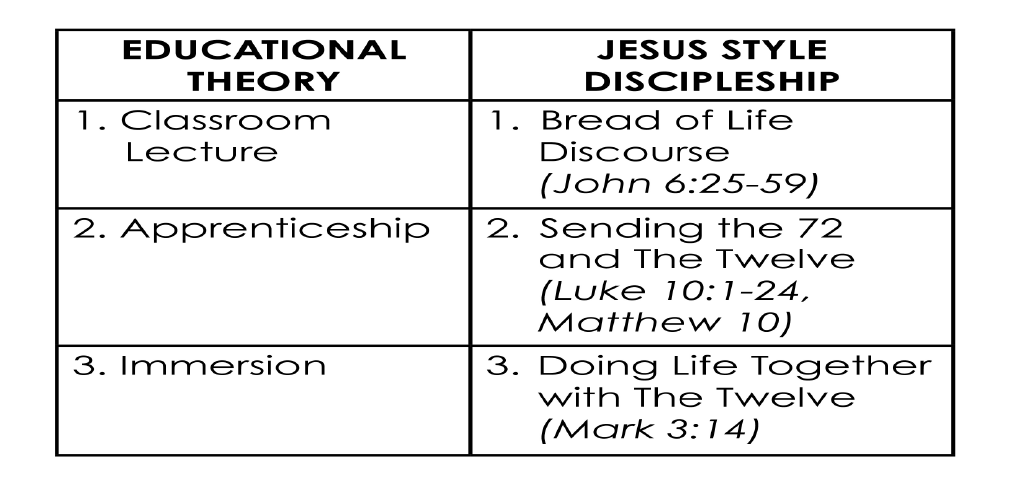Creating a Disciple Making Culture
FOOTNOTES
1
2
3
“Life change, in most any endeavor, is related to environment. If you want to develop physically, you join a fitness club. If you want to develop intellectually, you enroll in a university. If you want to develop spiritually you put yourself in a spiritual environment. But there are a range of spiritual environments, and each space lends itself to different goals. We create culture by using each environment (i.e. social space) for disciple-making.”
”
CREATING A DISCIPLE MAKING CULTURE
What is culture? Culture is the water we swim in. It’s captured in the cartoon where one fish swims up to another fish in another part of the ocean and asks “How’s the water over here?” The second fish says, “What’s water?” In other words, culture is something we can be oblivious to even when we’re in the midst of it, and it’s affecting everything about us.
Malcom Gladwell captures the power of culture well, in summarizing John Wesley’s strategies:
If you want to bring fundamental change to people’s lives and behavior, a change that will persist and influence others, you will need to create a community (i.e. culture) around them where these new beliefs could be practiced, expressed, and nurtured.1
John Wesley was one of the most effective disciple-makers in the history of the church. One author titled his biography, “England: Before and After Wesley” – so great was his impact on England. The lesson we learn from Wesley is how he designed the infrastructure of his ministry to make disciples. Simply put, Wesley moved the primary focus of church life from the Sunday service to a system of small groups where transparency and accountability were paramount.
Here are some foundational strategies that can get you started in creating a disciple making culture.
STEP 1
Define Your Destination
Our New Community Church Mission Statement reads in part:
“We exist to make disciples who live and love like Jesus.” It’s important to note that our mission statement is not to hold worship services, do small groups, to provide children/student ministries, put on community group events or any of the other endless list of activities that are part of contemporary ministry. This is not to diminish any of these vital ministries, but they’re properly understood as vehicles to the destination, not the destination itself. When we lose focus on the purpose of our existence we compromise our mission.
So, if the destination is to make disciples, how do we define a disciple? The Bible provides several definitions and descriptions. My favorite viral definition is as follows: “A disciple of Jesus is not just one who hears, but one who adheres to the teaching of Jesus.” This reflects the obedience-based model of Jesus rather than the information-based model of the contemporary church.
If you hold to my teachings, you are really my disciples. John 8:31 (NIV)
Everyone who hears these words of mine and puts them into practice is like the wise man who built his house upon the rock. Matthew 7:24 (NIV)
Go and make disciples…teaching them to obey everything I’ve commanded you. Matthew 28:19, 20 (NIV)
True disciples are not those who simply profess faith, nor are they perfect people, but there should be a clear progress in obedience that begins to emerge in a Christian’s life.
STEP 2
Move People Beyond the Sunday Crowd
Life change, in most any endeavor, is related to environment. If you want to develop physically, you join a fitness club. If you want to develop intellectually, you enroll in a university. If you want to develop spiritually you put yourself in a spiritual environment. But there are a range of spiritual environments, and each space lends itself to different goals. We create culture by using each environment (i.e. social space) for disciple-making. For example:
Worship Services are best leveraged for public teaching and corporate worship, not for knowing personal names or personal needs.
Small Groups are best leveraged for building community and providing personal support and encouragement, because you can know names and needs in a group of 5-12.
Discipleship Triads are best for transformation because the size (2-4) and gender separation (male and female) encourage transparency and the application of truth.
Each social space creates an environment for important but different components needed for growth in discipleship.2
Bottom line: We have to move people beyond the 9 and 11 o’clock crowd. You can’t make disciples at a distance. Effective teaching is essential but not sufficient. That’s why we say, “life change is catalyzed in the pulpit but maximized in groups” – particularly micro-groups.
STEP 3
Raise the Spiritual Temperature
Jesus-style discipleship is not the academic, mass-production, assembly-line process of going through a series of classes, curriculums, or programs. Rather, it is a highly relational process which allows for individual needs and questions to be dealt with in the context of real-life experiences. When we move people beyond the crowd and into smaller groups and intentional relationships, we raise the spiritual temperature and the possibility of life change. But while it is critical to have people in the right spiritual environments, it is not enough. We must also ensure that the right dynamics are happening in each social space. Also keep in mind that the larger the space, the longer it takes to heat up and get to crucible temperature. The smaller the space the quicker we get to crucible temperature.
Think of it this way: For water to be transformed into steam and to change physical properties…you must heat water to a boiling point.
How do you get people to love God, love people, care for the poor, etc.? Going to church once a week (even if it’s a great service) won’t do it. To bring people to a spiritual boiling point they must move beyond weekly attendance. They must occupy multiple social spaces and the right dynamics must happen in each space. Truth and transparency are critical ingredients, and transparency rarely happens outside small more intimate settings, especially micro groups.
Another quality control measure is to ask the F.I.T. question. Has there been sufficient frequency, intensity, and time to bring people to crucible temperature?
When you know your destination, move people beyond the Sunday crowd, and raise the spiritual temperature in those spaces, you are on your way to making disciples who live and live like Jesus.
STEP 4
Engage Best Practices
Educational theorists tell us that the best approach to learning/forming students is a mixture of classroom lecture, apprenticeship, and immersion.3
Classroom lecture is best for transmitting information. Apprenticeship is best for mastering skills. None of us would want someone performing heart surgery on us who had simply taken some classes and read books on surgery. We would want someone who had spent time in a hospital situation apprenticing under a skilled surgeon. The same holds true of any skilled trade: carpentry, plumbing, chef, etc. The third approach, immersion, is how an infant learns to speak a language. You simply put an infant in an environment where he is surrounded by French speaking people, and he will naturally learn to speak French.
But education theorists would tell us that optimal learning of any language would involve all three approaches: French classes 100-400, hiring a French tutor to work with you one-on-one, and spending a year in France immersing yourself in the culture. It’s fascinating to consider that Jesus, (the smartest man who ever lived) incorporated all three learning styles in the course of training His disciples.
Applying this to a local church situation, we should strive to incorporate all three approaches in our model. Classroom lectures take place in the worship service setting or other teaching venues. Apprenticeship takes place in the more personal small group and training settings. Immersion takes place in the context of community when the full range of group life experiences (large, small, micro,) and all your ministry teams are functioning optimally reinforcing the mission of disciple making.
CONCLUDING THOUGHTS
Over the past decades of my life, I’ve watched the church in America build thousands of mega churches, record hundreds of thousands of “decisions for Jesus” but lose the culture. Why? Because the secular culture has discipled the church far more effectively than the church has discipled its own people. We’ve been content to ask for decisions when Jesus calls us to make disciples.
To disciple the church and recapture the culture we must rebuild the discipleship culture of the church. We must embrace Jesus’ vision of creating colonies of heaven on earth. We call those colonies the church. It is made up of true disciples who have pledged their allegiance to Jesus and are actively doing his will in this world. Jesus invaded this planet two thousand years ago and in the words of Abraham Kuyper, planted a flag in this world declaring, “There is not a square inch in the whole domain of our human existence which Christ, who is sovereign over all, does not cry: ‘Mine’.”4 His movement continues to this day. He invites you to join the revolution!
FOOTNOTES:
1.Malcolm Gladwell, The Tipping Point: How Little Things Can Make a Big Difference (Boston: Little and Brown, 2002), 173
2.Bobby Harrington and Alex Absalom, Discipleship that Fits: The Five Kinds of Relationships God Uses to Help Us Grow (Grand Rapids: Zondervan, 2016), 49-62
3. Mike Breen, Seminar at Trinity Anglican Seminary ( Ambridge, PA for ECO Presbytery meeting, 2017)
4. Abraham Kuyper, A Centennial Reader, ed. James D. Brett, (Eerdmans, 1998), 488





